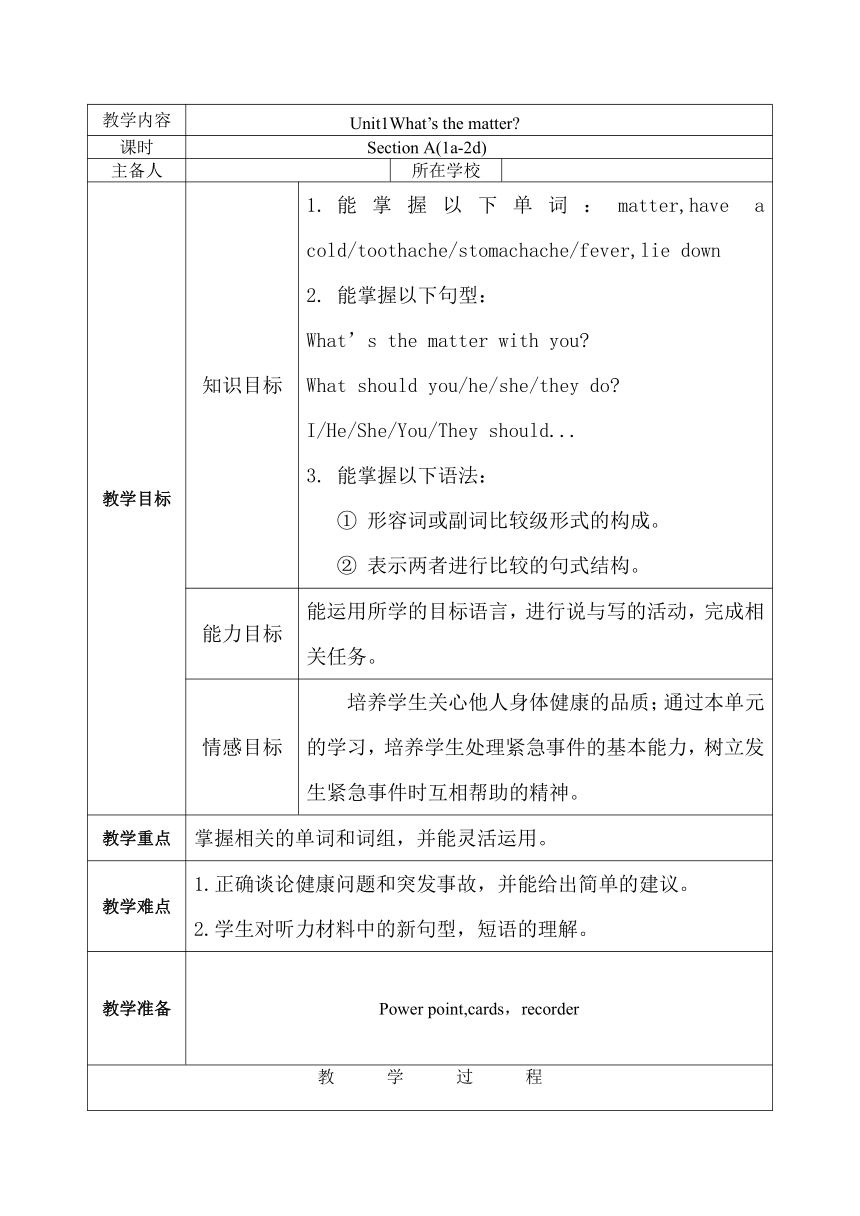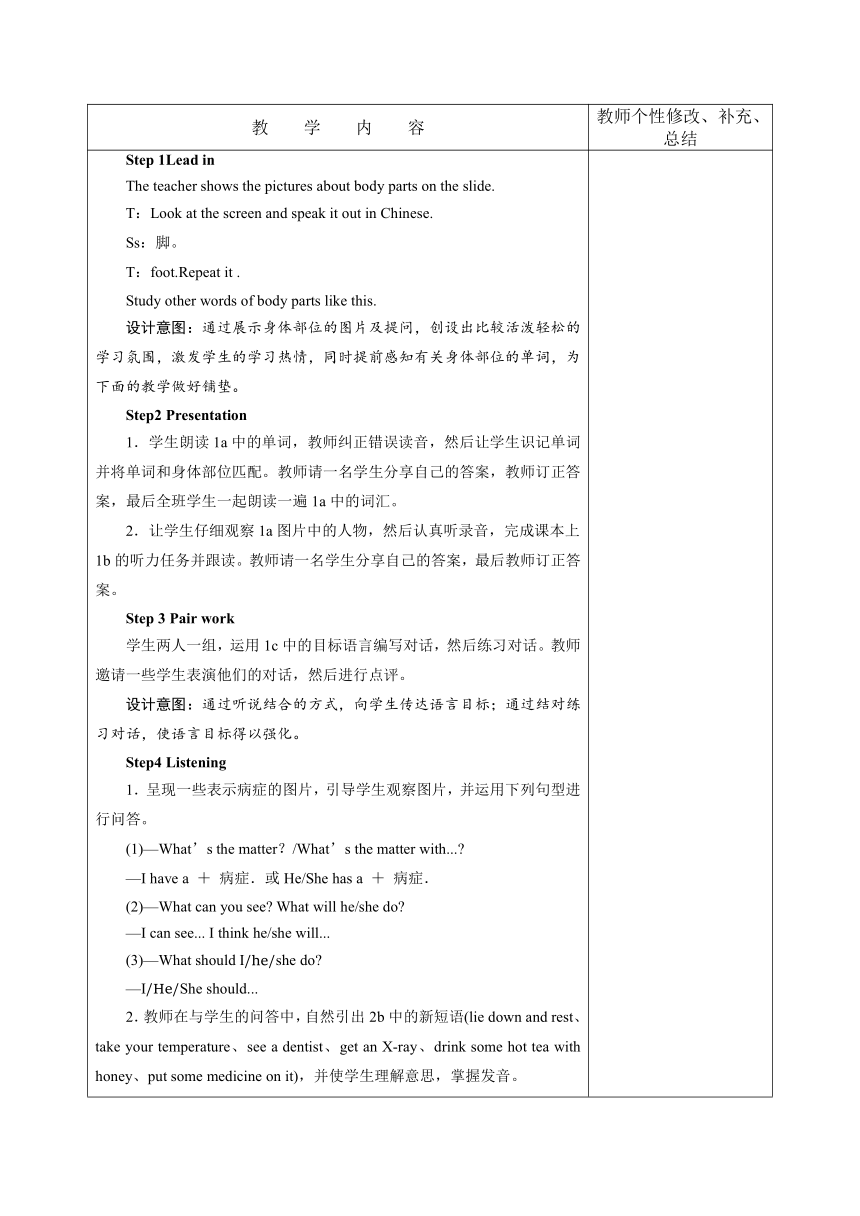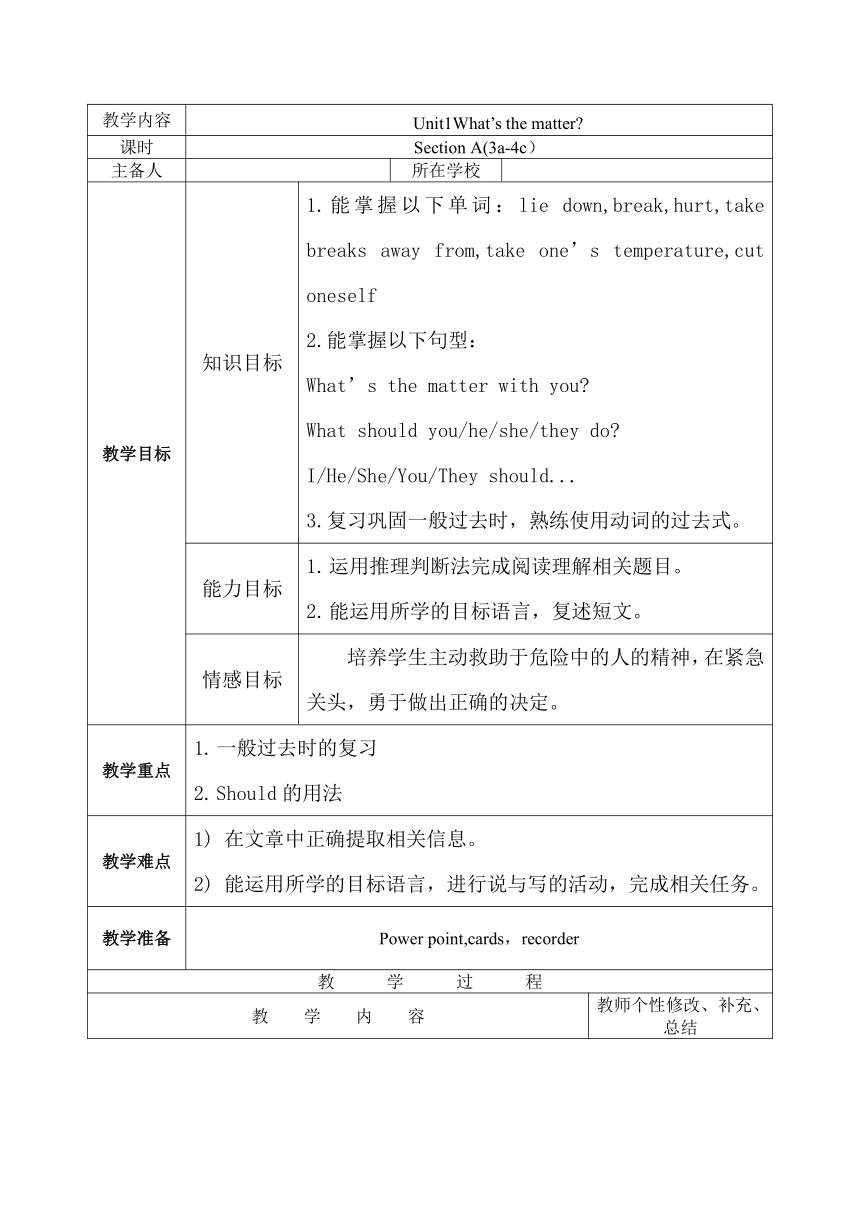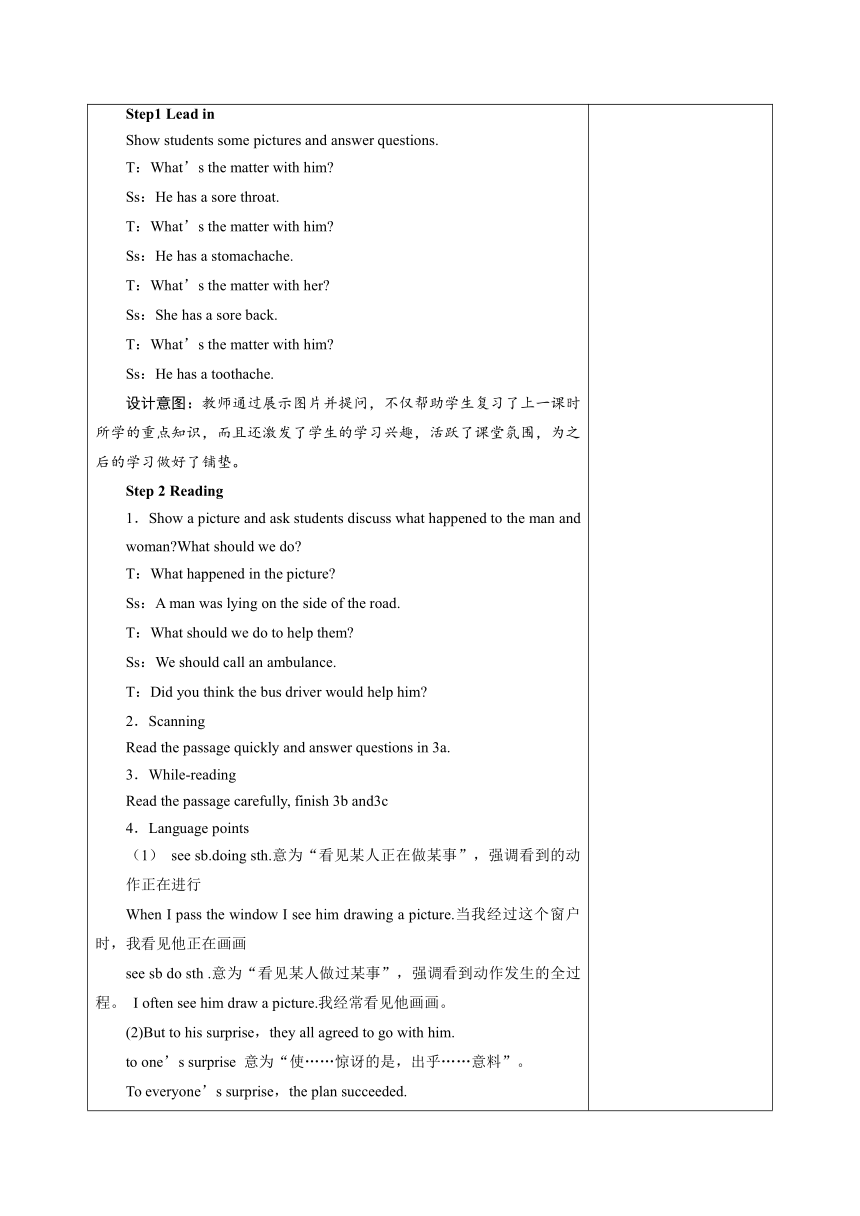人教版八年级英语下册Unit 1 What's the matter? 表格式教案(3课时)
文档属性
| 名称 | 人教版八年级英语下册Unit 1 What's the matter? 表格式教案(3课时) |  | |
| 格式 | zip | ||
| 文件大小 | 32.0KB | ||
| 资源类型 | 教案 | ||
| 版本资源 | 人教新目标(Go for it)版 | ||
| 科目 | 英语 | ||
| 更新时间 | 2022-03-17 13:48:58 | ||
图片预览





文档简介
教学内容 Unit1What’s the matter
课时 Section A(1a-2d)
主备人 所在学校
教学目标 知识目标 能掌握以下单词:matter,have a cold/toothache/stomachache/fever,lie down 能掌握以下句型: What’s the matter with you What should you/he/she/they do I/He/She/You/They should... 3. 能掌握以下语法: ① 形容词或副词比较级形式的构成。 ② 表示两者进行比较的句式结构。
能力目标 能运用所学的目标语言,进行说与写的活动,完成相关任务。
情感目标 培养学生关心他人身体健康的品质;通过本单元的学习,培养学生处理紧急事件的基本能力,树立发生紧急事件时互相帮助的精神。
教学重点 掌握相关的单词和词组,并能灵活运用。
教学难点 1.正确谈论健康问题和突发事故,并能给出简单的建议。 2.学生对听力材料中的新句型,短语的理解。
教学准备 Power point,cards,recorder
教 学 过 程
教 学 内 容 教师个性修改、补充、 总结
Step 1Lead in The teacher shows the pictures about body parts on the slide. T:Look at the screen and speak it out in Chinese. Ss:脚。 T:foot.Repeat it . Study other words of body parts like this. 设计意图:通过展示身体部位的图片及提问,创设出比较活泼轻松的学习氛围,激发学生的学习热情,同时提前感知有关身体部位的单词,为下面的教学做好铺垫。 Step2 Presentation 1.学生朗读1a中的单词,教师纠正错误读音,然后让学生识记单词并将单词和身体部位匹配。教师请一名学生分享自己的答案,教师订正答案,最后全班学生一起朗读一遍1a中的词汇。 2.让学生仔细观察1a图片中的人物,然后认真听录音,完成课本上1b的听力任务并跟读。教师请一名学生分享自己的答案,最后教师订正答案。 Step 3 Pair work 学生两人一组,运用1c中的目标语言编写对话,然后练习对话。教师邀请一些学生表演他们的对话,然后进行点评。 设计意图:通过听说结合的方式,向学生传达语言目标;通过结对练习对话,使语言目标得以强化。 Step4 Listening 1.呈现一些表示病症的图片,引导学生观察图片,并运用下列句型进行问答。 (1)—What’s the matter?/What’s the matter with... —I have a + 病症.或He/She has a + 病症. (2)—What can you see What will he/she do —I can see... I think he/she will... (3)—What should I/he/she do —I/He/She should... 2.教师在与学生的问答中,自然引出2b中的新短语(lie down and rest、take your temperature、see a dentist、get an X ray、drink some hot tea with honey、put some medicine on it),并使学生理解意思,掌握发音。 3.让学生认真观察2a的图片,按听到的对话顺序给图片标号,集体核对答案。 4.认真阅读2b中的单词和短语,再听一遍录音,将问题和建议匹配,完成后集体核对答案,并让学生跟读。 5.让学生利用2a和2b中的信息编写对话,并仿照2c的形式练习对话,然后邀请几组同学表演对话,教师再进行点评。 Step5 Role-play 1.大声朗读2d中的对话,读熟后与同伴结对练习,分角色表演对话。 2.Language points. (1)What’s the matter 该句型常用来询问对方的病情或其他不适的情况。其后可接with sb./sth.,以询问具体的对象(某人/某物),相当于What’s the trouble(with sb./sth.)?/What’s wrong(with sb./sth.)?/What’s up(with sb./sth.) (2)I have a cold. have v.得(病),患(病)。其第三人称单数形式为has,过去式和过去分词均为had。have作此义讲时,不能用于进行时态。“have+a/an+表示疾病的名词”意为“患(某种)病”。 Step 6 Summary. Key words and sentences:have a cold/stomachache/toothache/sore throat What’s the matter You should lie down and rest/go to the dentist/get an X ray/drink hot tea with honey.
课后反思: 改进及补充:
教学内容 Unit1What’s the matter
课时 Section A(3a-4c)
主备人 所在学校
教学目标 知识目标 1.能掌握以下单词:lie down,break,hurt,take breaks away from,take one’s temperature,cut oneself 2.能掌握以下句型: What’s the matter with you What should you/he/she/they do I/He/She/You/They should... 3.复习巩固一般过去时,熟练使用动词的过去式。
能力目标 运用推理判断法完成阅读理解相关题目。 能运用所学的目标语言,复述短文。
情感目标 培养学生主动救助于危险中的人的精神,在紧急关头,勇于做出正确的决定。
教学重点 一般过去时的复习 Should的用法
教学难点 1) 在文章中正确提取相关信息。 2) 能运用所学的目标语言,进行说与写的活动,完成相关任务。
教学准备 Power point,cards,recorder
教 学 过 程
教 学 内 容 教师个性修改、补充、 总结
Step1 Lead in Show students some pictures and answer questions. T:What’s the matter with him Ss:He has a sore throat. T:What’s the matter with him Ss:He has a stomachache. T:What’s the matter with her Ss:She has a sore back. T:What’s the matter with him Ss:He has a toothache. 设计意图:教师通过展示图片并提问,不仅帮助学生复习了上一课时所学的重点知识,而且还激发了学生的学习兴趣,活跃了课堂氛围,为之后的学习做好了铺垫。 Step 2 Reading 1.Show a picture and ask students discuss what happened to the man and woman What should we do T:What happened in the picture Ss:A man was lying on the side of the road. T:What should we do to help them Ss:We should call an ambulance. T:Did you think the bus driver would help him Scanning Read the passage quickly and answer questions in 3a. While-reading Read the passage carefully, finish 3b and3c Language points see sb.doing sth.意为“看见某人正在做某事”,强调看到的动作正在进行 When I pass the window I see him drawing a picture.当我经过这个窗户时,我看见他正在画画 see sb do sth .意为“看见某人做过某事”,强调看到动作发生的全过程。 I often see him draw a picture.我经常看见他画画。 (2)But to his surprise,they all agreed to go with him. to one’s surprise 意为“使……惊讶的是,出乎……意料”。 To everyone’s surprise,the plan succeeded. (3)“It’s sad that many people don’t want to help others because they don’t want any trouble,” says one passenger. 5 Post-reading. (1)I saw him playing(play)by the river at that time. (2)I often see him play(play)by the river. (3)I saw him walk(walk)across the bridge yesterday. (4)I saw her washing(wash)the dishes at this time yesterday. 设计意图:通过提问的方式引导学生层层深入,更容易理解文章;同时利用几大要点来梳理文章,不仅锻炼学生的思维能力,而且还复习到一般过去时的知识; 通过讨论,增进学生之间的友谊,同时增强学生的口语表达能力。 Step3 Grammar Focus-4c 1.教师先让学生自己浏览一遍Grammar Focus中的内容,然后请学生仿照下面一段对话进行表演。(doctor用大写D来表示) S1:What’s the matter S2:I have a stomachache. D:You shouldn’t eat so much next time. 2.学生表演完后,教师进行点评。 3.教师让学生浏览一遍4a的对话,并将横线空白处的内容补充完整,使每段对话通顺。教师订正答案。 4.教师邀请几组学生表演4a的对话,看哪一组学生表演得最好,并给予鼓励。 5.让学生独立完成4b的练习,然后请学生分享自己的答案和相应的建议,最后教师给予指点并订正答案。 6.小组活动。教师将学生分为四人一组,进行4c的练习,然后邀请一个小组上讲台进行表演,并由其他同学进行点评,最后教师鼓励学生并给出相应的意见。 7.Language points (1)have的用法。 ①作“有”讲。 例:I have a bag.我有一个包。②作“吃、喝”讲。例:have breakfast 吃早饭。③作“患病”讲。例:have a cold 感冒。 (2)Should I put some medicine on it 含有should的一般疑问句是将should提至主语前;其简略回答分别为“Yes,主语(人称代词)+should”和“No,主语(人称代词)+shouldn’t”。例:—Should I go to see a dentist 我应该去看牙医吗?—Yes,you should./No,you shouldn’t.是的,你应该去。/不,你不应该去。 Step4.Exercises 1.—Should I cut up the carrots?(作否定回答) —No,you shouldn’t. 2.My father has a headache.(改为一般疑问句) Does your father have a headache 3.Mrs.Hand’s daughter has a stomachache.(对画线部分提问) What’s the matter/trouble with Mrs.Hand’s daughter 4.Lisa should ask her parents for help.(对画线部分提问) What should Lisa do 5.Wu Dajing, a ____ Chinese skater, set a new world record at the Short Track World Cup last year. A. 25-years-old B. 25 year old C. 25-year-old D. 25 years old 6. I took the subway and ____ at the Downtown Station. A. got through B. got over C. got on D. got off 7.—The population of the poor is getting smaller and smaller. —____ the government, their living conditions have improved. A. As for B. Thanks to C. As a result of D. Thanks for
课后反思: 改进及补充:
教学内容 Unit1What’s the matter
课时 Section B(1a-2e)
主备人 所在学校
教学目标 知识目标 1) 能掌握以下单词:breathe,situation,take risks,get out of,be in control of,cut off,run out of,decision,spirit,fall down 能掌握以下句型: 进一步理解文章中的定语从句,时间状语从句等,理解文章含义。
能力目标 提高学生的阅读能力,理解文章的能力,总结归纳文章中知识点的能力。
情感目标 培养学生敢于面对生活中出现的挫折的精神,拥有坚强的意志力。
教学重点 1) 重点词汇及短语 2) 对文章的理解
教学难点 1.让学生学会怎样应对意外事故,并完成听力任务 2.阅读短文,理解其中的生词、短语和长难句,从而把握文章细节
教学准备 Power point,cards,recorder
教 学 过 程
教 学 内 容 教师个性修改、补充、 总结
Step 1 Lead in T:There are many accidents happening every day.But do you know how to deal with these problems What should you do when you have a nosebleed And what should you do when you cut yourself If you don’t know the answers to these questions,please don’t worry.Today we will learn how to deal with the problems. 设计意图:通过提出生活中经常出现的意外引出本节课所要学的内容,贴近生活,引起学生的学习兴趣。 Step 2 Listening 1.让学生仔细观察1a中的三幅图片,然后根据图片信息回答问题:What happened to them 2.小组讨论当出现1a中的意外情况时,我们应该怎么办。然后将1a中所给出的句子按正确的顺序排序,集体核对答案。 3.两人一组利用1a中的信息编写对话,并邀请几组学生表演对话。 A:What’s the matter with you B:I fell down and hurt my back. A:You should go to the hospital to get an X ray and rest for a few days. 4.学生齐读1b中的句子,为听力练习做好准备。 5.教师播放录音,学生认真听录音,将对话中护士所提的问题标注出来,完成1b,集体核对答案。 6.学生再认真听一遍录音,将相应的治疗方案的字母写在问题后面,完成1c,集体核对答案。 7.听第三遍录音,并跟读,整体感知对话。 设计意图:通过本环节的学习让学生知道出现这些意外后的应急措施,同时,对话练习又提升了学生的口语表达能力;通过反复听录音,提升学生的听力能力。 Step3 Lead in Introduce Aron Ralston。 T:Hello,everyone! Have you ever heard of Aron Ralston He is an American man who is interested in mountain climbing.He has many experiences in climbing mountains.But unluckily,he lost his right arm when he climbed in Utah.Do you want to know what happened to him Let’s read the story together. Ss:OK. 设计意图:通过简单介绍Aron Ralston的故事,设置悬念,引起学生的好奇心,引出本节课的学习内容。 Step4 Reading Pre-reading 学生朗读2a中的短语 让学生浏览2a的内容。老师引导:在运动的时候可能出现一些意外或是问题,看看A、B和C所代表的三项运动中经常出现的意外或是问题分别是什么,然后将代表三项运动的字母A、B 和C分别写在可能出现的意外或问题前面的横线上。学生完成后小组内互相交流答案。 While-reading 1.Scanning教师让学生快速阅读短文,回答下列问题以检查学生的理解情况。 (1)When did Aron almost lose his life (2)How did he save his life (3)What does “between a rock and a hard place” mean 2.教师根据学生阅读理解情况点拨短文中出现的重点和难点。 Post-reading 1.Ask students to work on 2c and 2d 2.According to the mind map to retell the story Step 5 Language points (1)...Aron is used to taking risks. be used to(doing)sth.习惯于(做)某事。例:He is used to looking after himself.他习惯于自己照顾自己。 (2)His love for mountain climbing is so great that he kept on climbing mountains even after this experience. so...that...意为“如此/这么……以至于……”,引导结果状语从句( 其中so是副词,常用来修饰形容词或副词)。例:He is so young that he can’t look after himself.他太小了无法照顾自己。 Step 4 Exercises 1.Andrew often does DIY with different ______ ( knife ) in his free time. 2.Aron Ralston is a great mountain ________ (climb) 3.You should learn to make a _______ (decide) by yourself 4.We need to realize the ___________ (important) of learning English. 5.We couldn’t believe it when we heard of his ______ (die) 6.He is used to _______ (have) a cup of tea first after getting up. 设计意图:通过本环节的学习使学生对Aron Ralston的事迹有了进一步的了解,同时Aron Ralston 的优秀品质也使学生受到了教育;而且通过相应的训练让学生对重要知识点进行了巩固练习;通过回答教材上的问题,有助于学生的阅读水平和口语能力的提高,同时又巩固加深了学生对文章的理解。
课时 Section A(1a-2d)
主备人 所在学校
教学目标 知识目标 能掌握以下单词:matter,have a cold/toothache/stomachache/fever,lie down 能掌握以下句型: What’s the matter with you What should you/he/she/they do I/He/She/You/They should... 3. 能掌握以下语法: ① 形容词或副词比较级形式的构成。 ② 表示两者进行比较的句式结构。
能力目标 能运用所学的目标语言,进行说与写的活动,完成相关任务。
情感目标 培养学生关心他人身体健康的品质;通过本单元的学习,培养学生处理紧急事件的基本能力,树立发生紧急事件时互相帮助的精神。
教学重点 掌握相关的单词和词组,并能灵活运用。
教学难点 1.正确谈论健康问题和突发事故,并能给出简单的建议。 2.学生对听力材料中的新句型,短语的理解。
教学准备 Power point,cards,recorder
教 学 过 程
教 学 内 容 教师个性修改、补充、 总结
Step 1Lead in The teacher shows the pictures about body parts on the slide. T:Look at the screen and speak it out in Chinese. Ss:脚。 T:foot.Repeat it . Study other words of body parts like this. 设计意图:通过展示身体部位的图片及提问,创设出比较活泼轻松的学习氛围,激发学生的学习热情,同时提前感知有关身体部位的单词,为下面的教学做好铺垫。 Step2 Presentation 1.学生朗读1a中的单词,教师纠正错误读音,然后让学生识记单词并将单词和身体部位匹配。教师请一名学生分享自己的答案,教师订正答案,最后全班学生一起朗读一遍1a中的词汇。 2.让学生仔细观察1a图片中的人物,然后认真听录音,完成课本上1b的听力任务并跟读。教师请一名学生分享自己的答案,最后教师订正答案。 Step 3 Pair work 学生两人一组,运用1c中的目标语言编写对话,然后练习对话。教师邀请一些学生表演他们的对话,然后进行点评。 设计意图:通过听说结合的方式,向学生传达语言目标;通过结对练习对话,使语言目标得以强化。 Step4 Listening 1.呈现一些表示病症的图片,引导学生观察图片,并运用下列句型进行问答。 (1)—What’s the matter?/What’s the matter with... —I have a + 病症.或He/She has a + 病症. (2)—What can you see What will he/she do —I can see... I think he/she will... (3)—What should I/he/she do —I/He/She should... 2.教师在与学生的问答中,自然引出2b中的新短语(lie down and rest、take your temperature、see a dentist、get an X ray、drink some hot tea with honey、put some medicine on it),并使学生理解意思,掌握发音。 3.让学生认真观察2a的图片,按听到的对话顺序给图片标号,集体核对答案。 4.认真阅读2b中的单词和短语,再听一遍录音,将问题和建议匹配,完成后集体核对答案,并让学生跟读。 5.让学生利用2a和2b中的信息编写对话,并仿照2c的形式练习对话,然后邀请几组同学表演对话,教师再进行点评。 Step5 Role-play 1.大声朗读2d中的对话,读熟后与同伴结对练习,分角色表演对话。 2.Language points. (1)What’s the matter 该句型常用来询问对方的病情或其他不适的情况。其后可接with sb./sth.,以询问具体的对象(某人/某物),相当于What’s the trouble(with sb./sth.)?/What’s wrong(with sb./sth.)?/What’s up(with sb./sth.) (2)I have a cold. have v.得(病),患(病)。其第三人称单数形式为has,过去式和过去分词均为had。have作此义讲时,不能用于进行时态。“have+a/an+表示疾病的名词”意为“患(某种)病”。 Step 6 Summary. Key words and sentences:have a cold/stomachache/toothache/sore throat What’s the matter You should lie down and rest/go to the dentist/get an X ray/drink hot tea with honey.
课后反思: 改进及补充:
教学内容 Unit1What’s the matter
课时 Section A(3a-4c)
主备人 所在学校
教学目标 知识目标 1.能掌握以下单词:lie down,break,hurt,take breaks away from,take one’s temperature,cut oneself 2.能掌握以下句型: What’s the matter with you What should you/he/she/they do I/He/She/You/They should... 3.复习巩固一般过去时,熟练使用动词的过去式。
能力目标 运用推理判断法完成阅读理解相关题目。 能运用所学的目标语言,复述短文。
情感目标 培养学生主动救助于危险中的人的精神,在紧急关头,勇于做出正确的决定。
教学重点 一般过去时的复习 Should的用法
教学难点 1) 在文章中正确提取相关信息。 2) 能运用所学的目标语言,进行说与写的活动,完成相关任务。
教学准备 Power point,cards,recorder
教 学 过 程
教 学 内 容 教师个性修改、补充、 总结
Step1 Lead in Show students some pictures and answer questions. T:What’s the matter with him Ss:He has a sore throat. T:What’s the matter with him Ss:He has a stomachache. T:What’s the matter with her Ss:She has a sore back. T:What’s the matter with him Ss:He has a toothache. 设计意图:教师通过展示图片并提问,不仅帮助学生复习了上一课时所学的重点知识,而且还激发了学生的学习兴趣,活跃了课堂氛围,为之后的学习做好了铺垫。 Step 2 Reading 1.Show a picture and ask students discuss what happened to the man and woman What should we do T:What happened in the picture Ss:A man was lying on the side of the road. T:What should we do to help them Ss:We should call an ambulance. T:Did you think the bus driver would help him Scanning Read the passage quickly and answer questions in 3a. While-reading Read the passage carefully, finish 3b and3c Language points see sb.doing sth.意为“看见某人正在做某事”,强调看到的动作正在进行 When I pass the window I see him drawing a picture.当我经过这个窗户时,我看见他正在画画 see sb do sth .意为“看见某人做过某事”,强调看到动作发生的全过程。 I often see him draw a picture.我经常看见他画画。 (2)But to his surprise,they all agreed to go with him. to one’s surprise 意为“使……惊讶的是,出乎……意料”。 To everyone’s surprise,the plan succeeded. (3)“It’s sad that many people don’t want to help others because they don’t want any trouble,” says one passenger. 5 Post-reading. (1)I saw him playing(play)by the river at that time. (2)I often see him play(play)by the river. (3)I saw him walk(walk)across the bridge yesterday. (4)I saw her washing(wash)the dishes at this time yesterday. 设计意图:通过提问的方式引导学生层层深入,更容易理解文章;同时利用几大要点来梳理文章,不仅锻炼学生的思维能力,而且还复习到一般过去时的知识; 通过讨论,增进学生之间的友谊,同时增强学生的口语表达能力。 Step3 Grammar Focus-4c 1.教师先让学生自己浏览一遍Grammar Focus中的内容,然后请学生仿照下面一段对话进行表演。(doctor用大写D来表示) S1:What’s the matter S2:I have a stomachache. D:You shouldn’t eat so much next time. 2.学生表演完后,教师进行点评。 3.教师让学生浏览一遍4a的对话,并将横线空白处的内容补充完整,使每段对话通顺。教师订正答案。 4.教师邀请几组学生表演4a的对话,看哪一组学生表演得最好,并给予鼓励。 5.让学生独立完成4b的练习,然后请学生分享自己的答案和相应的建议,最后教师给予指点并订正答案。 6.小组活动。教师将学生分为四人一组,进行4c的练习,然后邀请一个小组上讲台进行表演,并由其他同学进行点评,最后教师鼓励学生并给出相应的意见。 7.Language points (1)have的用法。 ①作“有”讲。 例:I have a bag.我有一个包。②作“吃、喝”讲。例:have breakfast 吃早饭。③作“患病”讲。例:have a cold 感冒。 (2)Should I put some medicine on it 含有should的一般疑问句是将should提至主语前;其简略回答分别为“Yes,主语(人称代词)+should”和“No,主语(人称代词)+shouldn’t”。例:—Should I go to see a dentist 我应该去看牙医吗?—Yes,you should./No,you shouldn’t.是的,你应该去。/不,你不应该去。 Step4.Exercises 1.—Should I cut up the carrots?(作否定回答) —No,you shouldn’t. 2.My father has a headache.(改为一般疑问句) Does your father have a headache 3.Mrs.Hand’s daughter has a stomachache.(对画线部分提问) What’s the matter/trouble with Mrs.Hand’s daughter 4.Lisa should ask her parents for help.(对画线部分提问) What should Lisa do 5.Wu Dajing, a ____ Chinese skater, set a new world record at the Short Track World Cup last year. A. 25-years-old B. 25 year old C. 25-year-old D. 25 years old 6. I took the subway and ____ at the Downtown Station. A. got through B. got over C. got on D. got off 7.—The population of the poor is getting smaller and smaller. —____ the government, their living conditions have improved. A. As for B. Thanks to C. As a result of D. Thanks for
课后反思: 改进及补充:
教学内容 Unit1What’s the matter
课时 Section B(1a-2e)
主备人 所在学校
教学目标 知识目标 1) 能掌握以下单词:breathe,situation,take risks,get out of,be in control of,cut off,run out of,decision,spirit,fall down 能掌握以下句型: 进一步理解文章中的定语从句,时间状语从句等,理解文章含义。
能力目标 提高学生的阅读能力,理解文章的能力,总结归纳文章中知识点的能力。
情感目标 培养学生敢于面对生活中出现的挫折的精神,拥有坚强的意志力。
教学重点 1) 重点词汇及短语 2) 对文章的理解
教学难点 1.让学生学会怎样应对意外事故,并完成听力任务 2.阅读短文,理解其中的生词、短语和长难句,从而把握文章细节
教学准备 Power point,cards,recorder
教 学 过 程
教 学 内 容 教师个性修改、补充、 总结
Step 1 Lead in T:There are many accidents happening every day.But do you know how to deal with these problems What should you do when you have a nosebleed And what should you do when you cut yourself If you don’t know the answers to these questions,please don’t worry.Today we will learn how to deal with the problems. 设计意图:通过提出生活中经常出现的意外引出本节课所要学的内容,贴近生活,引起学生的学习兴趣。 Step 2 Listening 1.让学生仔细观察1a中的三幅图片,然后根据图片信息回答问题:What happened to them 2.小组讨论当出现1a中的意外情况时,我们应该怎么办。然后将1a中所给出的句子按正确的顺序排序,集体核对答案。 3.两人一组利用1a中的信息编写对话,并邀请几组学生表演对话。 A:What’s the matter with you B:I fell down and hurt my back. A:You should go to the hospital to get an X ray and rest for a few days. 4.学生齐读1b中的句子,为听力练习做好准备。 5.教师播放录音,学生认真听录音,将对话中护士所提的问题标注出来,完成1b,集体核对答案。 6.学生再认真听一遍录音,将相应的治疗方案的字母写在问题后面,完成1c,集体核对答案。 7.听第三遍录音,并跟读,整体感知对话。 设计意图:通过本环节的学习让学生知道出现这些意外后的应急措施,同时,对话练习又提升了学生的口语表达能力;通过反复听录音,提升学生的听力能力。 Step3 Lead in Introduce Aron Ralston。 T:Hello,everyone! Have you ever heard of Aron Ralston He is an American man who is interested in mountain climbing.He has many experiences in climbing mountains.But unluckily,he lost his right arm when he climbed in Utah.Do you want to know what happened to him Let’s read the story together. Ss:OK. 设计意图:通过简单介绍Aron Ralston的故事,设置悬念,引起学生的好奇心,引出本节课的学习内容。 Step4 Reading Pre-reading 学生朗读2a中的短语 让学生浏览2a的内容。老师引导:在运动的时候可能出现一些意外或是问题,看看A、B和C所代表的三项运动中经常出现的意外或是问题分别是什么,然后将代表三项运动的字母A、B 和C分别写在可能出现的意外或问题前面的横线上。学生完成后小组内互相交流答案。 While-reading 1.Scanning教师让学生快速阅读短文,回答下列问题以检查学生的理解情况。 (1)When did Aron almost lose his life (2)How did he save his life (3)What does “between a rock and a hard place” mean 2.教师根据学生阅读理解情况点拨短文中出现的重点和难点。 Post-reading 1.Ask students to work on 2c and 2d 2.According to the mind map to retell the story Step 5 Language points (1)...Aron is used to taking risks. be used to(doing)sth.习惯于(做)某事。例:He is used to looking after himself.他习惯于自己照顾自己。 (2)His love for mountain climbing is so great that he kept on climbing mountains even after this experience. so...that...意为“如此/这么……以至于……”,引导结果状语从句( 其中so是副词,常用来修饰形容词或副词)。例:He is so young that he can’t look after himself.他太小了无法照顾自己。 Step 4 Exercises 1.Andrew often does DIY with different ______ ( knife ) in his free time. 2.Aron Ralston is a great mountain ________ (climb) 3.You should learn to make a _______ (decide) by yourself 4.We need to realize the ___________ (important) of learning English. 5.We couldn’t believe it when we heard of his ______ (die) 6.He is used to _______ (have) a cup of tea first after getting up. 设计意图:通过本环节的学习使学生对Aron Ralston的事迹有了进一步的了解,同时Aron Ralston 的优秀品质也使学生受到了教育;而且通过相应的训练让学生对重要知识点进行了巩固练习;通过回答教材上的问题,有助于学生的阅读水平和口语能力的提高,同时又巩固加深了学生对文章的理解。
同课章节目录
- Unit 1 What's the matter?
- Section A
- Section B
- Unit 2 I'll help to clean up the city parks.
- Section A
- Section B
- Unit 3 Could you please clean your room?
- Section A
- Section B
- Unit 4 Why don't you talk to your parents?
- Section A
- Section B
- Unit 5 What were you doing when the rainstorm came
- Section A
- Section B
- Review of Units 1-5
- Unit 6 An old man tried to move the mountains.
- Section A
- Section B
- Unit 7 What's the highest mountain in the world?
- Section A
- Section B
- Unit 8 Have you read Treasure Island yet?
- Section A
- Section B
- Unit 9 Have you ever been to a museum?
- Section A
- Section B
- Unit 10 I've had this bike for three years.
- Section A
- Section B
